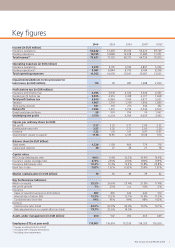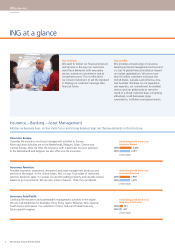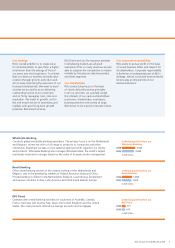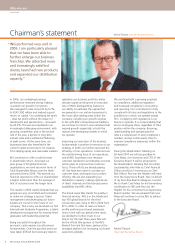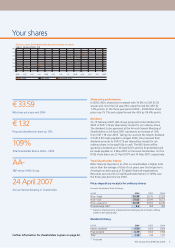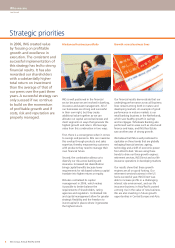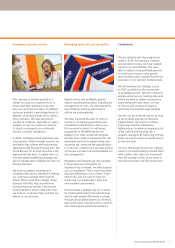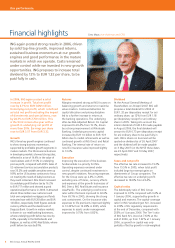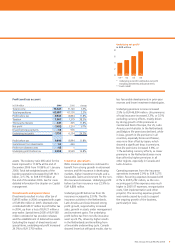ING Direct 2006 Annual Report Download - page 13
Download and view the complete annual report
Please find page 13 of the 2006 ING Direct annual report below. You can navigate through the pages in the report by either clicking on the pages listed below, or by using the keyword search tool below to find specific information within the annual report.
Good housekeeping
Capital management is to a large
extent good housekeeping, with
the establishment of proper policies,
procedures and routines. At the beginning
of each year plans are prepared describing
all funding transactions. Procedures were
written for capital contributions into the
business and also for pension funds.
The target maturity profi le and interest
rate profi le of the core debt are also being
written into policy. The policy for hedging
employee options was also renewed to
take into account the changing regulatory
and tax landscape.
We are also continuously streamlining the
organisation and tidying up the corporate
structure. 2006 was again a very active
year with many divestments (some of
which will be formally fi nalised in 2007):
Piraeus, Williams de Broë, Deutsche
Hypothekenbank, Nationale Borg,
Degussa Bank and ING Trust. ING bought
a mutual fund manager in Taiwan and
the pension administrator AZL in the
Netherlands.
Capital management
ING strengthened efforts to monitor and
manage capital adequacy and execute capital
markets transactions. To this end a centralised
capital management function was created with
the benefi t that capital adequacy requirements
are balanced with fi nancial fl exibility. This helps
meet strategic objectives and contributes to an
effi cient allocation of capital.
Stronger capital position
The capital position of ING was further
enhanced during 2006, thanks to
continued strong profi tability of the
business. Financings in the market
throughout the year raised further hybrid
Tier-1 and core debt for ING Group, lower
Tier-2 for ING Bank and core debt for
ING Insurance. Hybrid Tier-1 debt raised
for ING Group is on-lent to either ING
Bank or ING Insurance under the same
conditions as the original instruments.
Core debt is debt that is on-lent as equity
to subsidiaries.
ING stayed well within its key target
capital ratios: a maximum of 10% core
debt for ING Group, a maximum of 15%
core debt for ING Insurance and at least
a 7.2% Tier-1 ratio for ING Bank. ING’s
objective is to have AA ratings for ING
Group, ING Bank and ING Insurance.
Risk-weighted assets grew moderately
on the banking side by 5.7% to EUR 338
billion. This modest growth was made
possible through the execution of an
ambitious securitisation plan that released
a further EUR 8.1 billion of risk-weighted
assets from the balance sheet during the
year. The underlying growth of assets
produced by the business was therefore
much higher.
Implementation of Basel II
Much attention was paid during 2006
to the implementation of Basel II and
its three-pillar framework. Pillar 1 calculates
the minimum capital requirement. Pillar 2
is an overall review by the regulator of
capital adequacy, while Pillar 3 concerns
the external reporting.
We constantly examine our capitalisation
from multiple viewpoints and analyse
whether solvency targets need to be
adjusted.
Managing ING Insurance’s free surplus
In 2006, the management of the free
surplus of ING Insurance was enhanced,
which is the part of fi nancial resources
available above the amount of economic
capital employed. This surplus may have
to be held by the businesses due to
regulatory and rating agency constraints.
To the extent the free surplus is not
constrained, ING is free to employ it
elsewhere to increase organic growth.
02 03 04 05 06
4
0
8
12
16
20
19.9 14.4 10.2 9.4 9.0
Debt/equity ratio ING Group
in percentages
Target 10%
Capital base ING Groep N.V.
31 December 31 December
In EUR million 2006 2005
Shareholders’ equity (in parent) 38,266 36,736
+ Group hybrid capital 7,606 7,883
+ Group leverage (core debt) 4,210 3,969
Total capitalisation (Bank + Insurance) 50,082 48,588
–/– Revaluation reserves fi xed income and other 3,352 6,477
–/– Group leverage (core debt) (d) 4,210 3,969
Adjusted equity (e) 42,520 38,142
Debt/equity ratio (d/(d+e)) 9.01% 9.43%
ING Group Annual Review 2006 11


